Indonesia car survey: overcoming barriers of car purchase
Oct 08, 2024
Demand for passenger cars is declining The Indonesian automotive market in 2024 presents both
Vietnam consumer trends 2023
Vietnam Consumer Trends 2023 explores the nine reasons that Vietnam will prosper in the next decade.
Whatever the short-term doom and gloom in the media about the property sector (5.5% of GDP), domestic consumer demand (which represents 55% of Vietnam’s GDP) remains strong. Consumer demand for hospitality, services, tourism, and retail goods is high. Domestic tourism has really replenished and filled the void of international tourism. Vietnam has a digitally savvy population. In 2015, a US$3 billion internet economy. In 2022 a US$23 billion internet economy. There is no winter coming to the consumer economy of Vietnam. It is spring. Make the most of it.
12-minute read
The number one enabler for Vietnam’s economic success primarily has been the structure of its working population and its youth therein and the high labour participation of women, providing a low dependency ratio. Vietnam has gone through a decade with average GDP growth of 6%. Vietnam has strong domestic consumer demand and Cimgio expects these levels of economic growth to be maintained over the next decade.
The change will come in 2036 as the population structure changes The economic challenge lies in moving from a lower-middle to an upper-middle-income country as these population changes take hold.
Vietnam will stand out as a high-growth economy over the next ten years. These are the key nine reasons why Vietnam will continue to prosper over the next decade and growth will be the strongest in Asia and across most of the world.
The Vietnam consumer trends 2023 presentation explores the nine reasons that Vietnam will prosper in the next decade.
Among the nine drivers of Vietnam’s success presented in the Vietnam consumer trends 2023 presentation, this is the one that enabled all that rapid growth Vietnam has experienced over the last decade. This reason will continue to fuel the economy over the coming decade. The structure of Vietnam’s population with high labour participation, which is mostly driven by women. The resulting dependency ratio between working persons to non-working dependents is very low.
Vietnam has a large workforce. 62% of the population is of working age between 20 to 64. Of this age group 88% of the females are engaged in labour, working, earning money and adding to Vietnam’s gross national product.
Vietnam’s female participation in the labour force is far ahead of other nations; Indonesia’s is at 40% and India’s is at 25%. The chart is just showing you the age profile of the working population in Vietnam. Looking back a decade, nearly 57% of the working population was between 20 and 39.
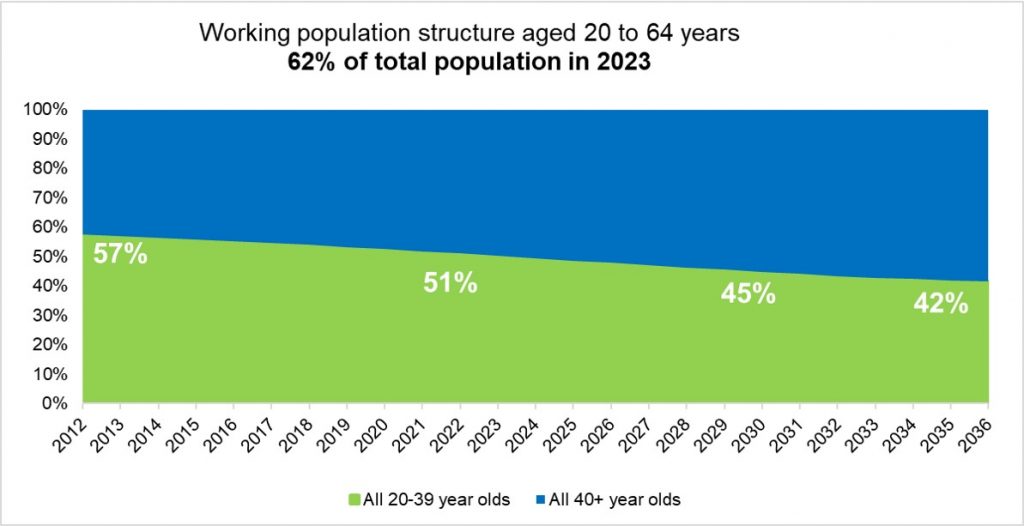
Vietnam’s population structure has enabled a fast-growing economy over the last ten years, 96% of men in this age group work and 88% of women in this age group work. In 2023, 51% of the working population are between the ages of 20 and 39. This cohort has grown up in a digital era. So those working in an office environment are used to digital efficiency. Those working in a factory are young, active, dynamic, fit and healthy. Vietnam’s workforce is comparatively cheap. The 2023 minimum monthly wages in Saigon are US$200, just 60% of the minimum in Guangzhou at US$332.
Vietnam’s population structure and high labour participation significantly lower dependency ratios to just 0.7 per employed person. This gives GDP a huge boost.
The continued urbanisation and the corresponding decline in the rural population are inevitable. As is the growth of the silver generation, those aged over 50 years and the decline of youth, aged 0 to 14 years. The birth rate is declining rapidly and will not sustain Vietnam’s population going forward.
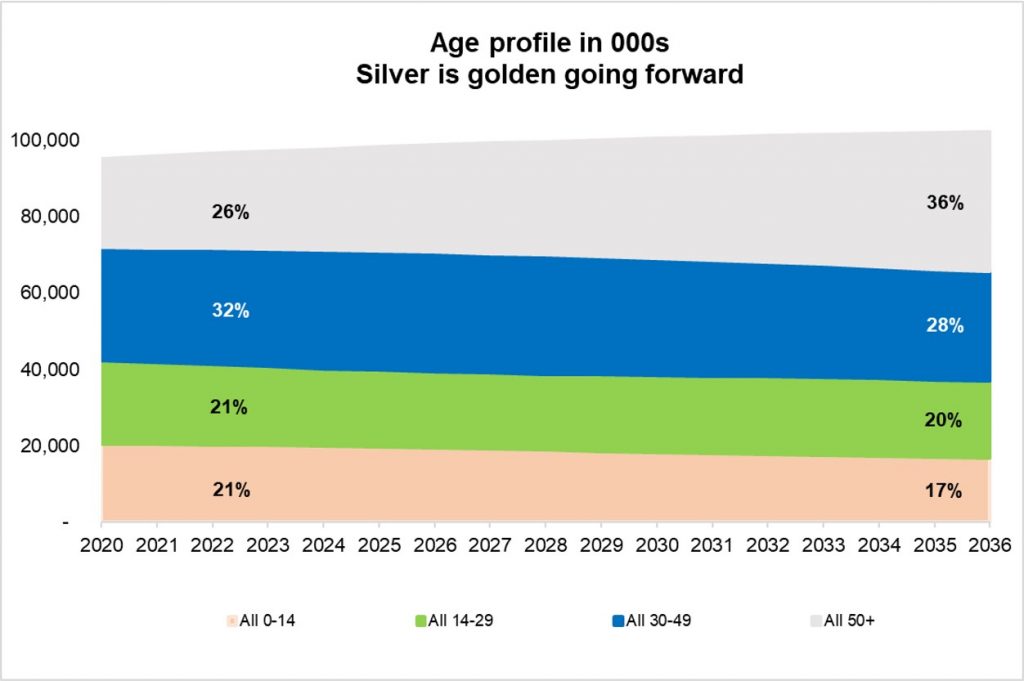
Brands selling to this young age cohort will find growth far harder to attain. In contrast, the silver generation is underserved by businesses. It’s much easier to sell products to a demographic that is growing than one that is shrinking. The silver generation has more money and many needs that are not addressed.
Download the free presentation on Vietnam’s silver generation
The Vietnam consumer trends 2023 presentation highlights how this demographic advantage will fade from 2036. By 2036 the working population is dominated by people over 40 years of age. An older working population tends to be less dynamic, active and healthy. Vietnam’s ageing profile creates a significant increase in older dependents. In the late 2030s, an ageing population is really going to take hold. By the 2040s society will grapple with looking after the elderly.
Vietnam’s GDP growth in 2023 is expected to reach 6.3%. Vietnam’s per capita GDP in 2022 was US$4,104. The Vietnamese economy grew by 8% in 2022, attracting a healthy trade surplus, a continued rise in foreign direct investment disbursements and 1,700,000 new jobs. The consumer price index grew 4.4% in the fourth quarter of 2022 over the prior year, bringing annual inflation to 3.15%. Retail sales of goods and services grew 19.8% and long surpassed pre-Covid 2019 levels.
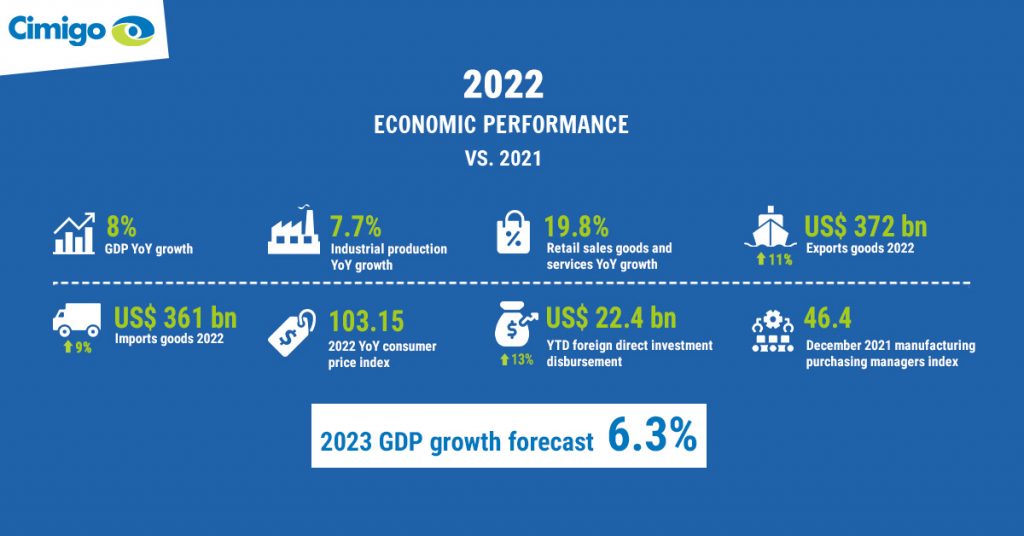
Whist domestic consumer demand is strong there are risks and business confidence (in contrast to consumer confidence) has dampened. Despite this Cimigo expects Vietnam’s GDP growth in 2023 to reach 6.3%.
In 2021, the per capita GDP was US$3,800 in Vietnam. Vietnam’s economy is reasonably close to Indonesia and ahead of the Philippines and Myanmar. But there is a long journey ahead to reach the economic clout of Thailand or Malaysia. Note that the economies of China, India and Thailand, all shrank in 2021 as the pandemic took its toll.
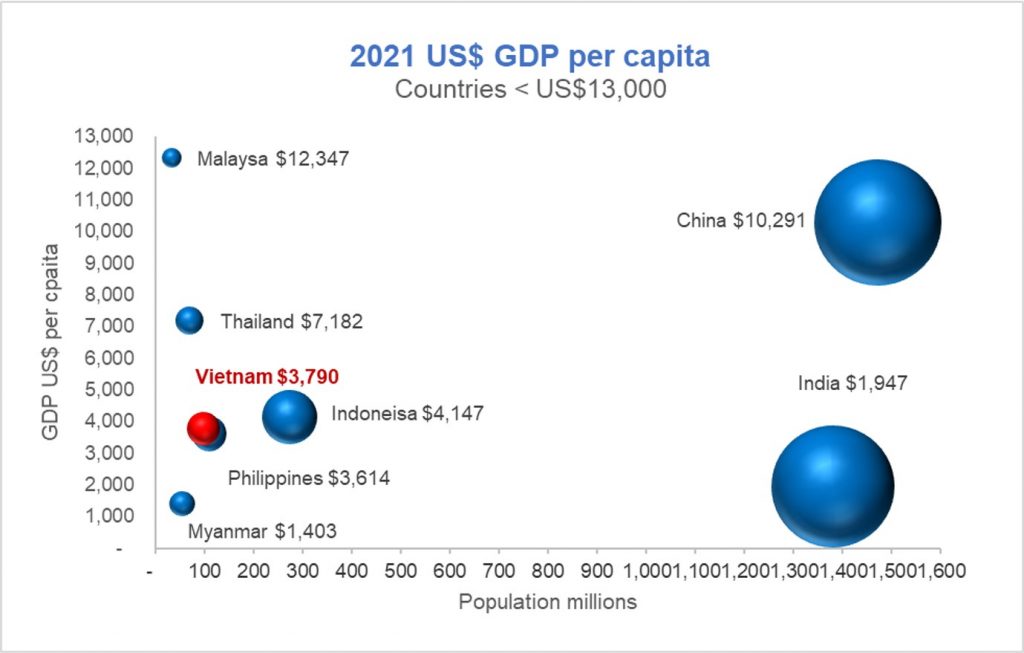
In 2022, Vietnam’s GDP per capita reached US$4,100 and the economy grew by 8%. Vietnam is digitally savvy. 97% of adults have a smartphone. Internet penetration is nearly 80% and Vietnam has a high proportion of the population that is banked.
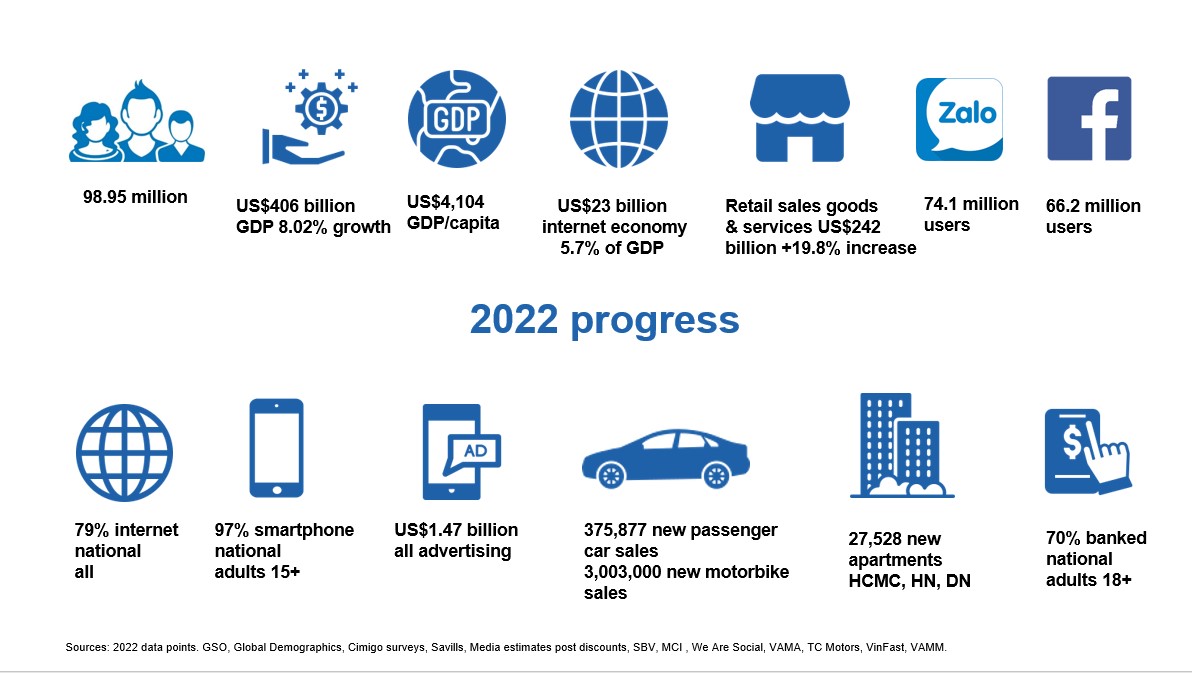
However, Cimigo’s CEO Pulse indicates a recent crisis in business confidence. Business confidence in CEO Pulse faltered in October 2022. As of December 2022, 56% of CEOs expect business conditions to worsen in the coming year. Business confidence faltered owing to concerns over 1) rising consumer domestic consumer prices, 2) lower growth in key export markets impacting manufacturing output and 3) woes in the property sector and the related financing therein.
However, please do note that the property sector represents 5.5% of GDP. It hurts for those in this sector, but it need not dampen the outlook for the whole economy. But unfortunately, business sentiment has reacted to the media headlines, full of scandals and negative news around the property sector.
Free trade agreements abound for Vietnam. Vietnam leads the charts on global trade interconnectivity. Vietnam’s global interconnectivity in 2022 was 180%. Interconnected global trade is defined as imports plus exports expressed as a % of GDP.
Vietnam manufacturers experienced the impact of slowing export markets in Q4 2022 but growth returned in February 2023. The S&P Global Vietnam Manufacturing Purchasing Managers’ Index™ (PMI®) business expectations outlook, dropped to a 14-month low in November and confidence in the year-ahead outlook for production remained relatively muted in December. However, there were early positive signals for exports being less strained with new export business up for the first time in three months in January and the opening of China boosting confidence. Whilst manufacturing slowed in Q4 2022, growth returned in February 2023.
The risks of overreliance on China were realised as the zero Covid approach locked down the country. Big brands and their suppliers are expanding production in Vietnam to serve export markets beyond China. These include; Samsung, Intel, Komatsu, Lenovo, Apple, Xiaomi Hanwa and LG amongst others.
However, their suppliers are rarely Vietnamese companies. Moving beyond an assembly line towards greater value-added production is challenging. Key barriers include managerial staffing shortages, inferior infrastructure impacting logistic costs and decision apathy causing licensing delays. Overcoming these challenges are essential to move Vietnam’s economy from a lower-middle to an upper-middle-income country.
Local demand for retail goods and services accounts for 55% of GDP. It is the economic engine. Whilst it’s troubling what’s happening in the property sector, these are the two main areas that fuel the economy; retail demand (55%) and (manufacturing 25%)
Consumer demand for retail goods and services is strong growing by 20% over 2021. Compared to demand for retail goods and services pre-Covid in 2019, sales grew by 15% in 2022.
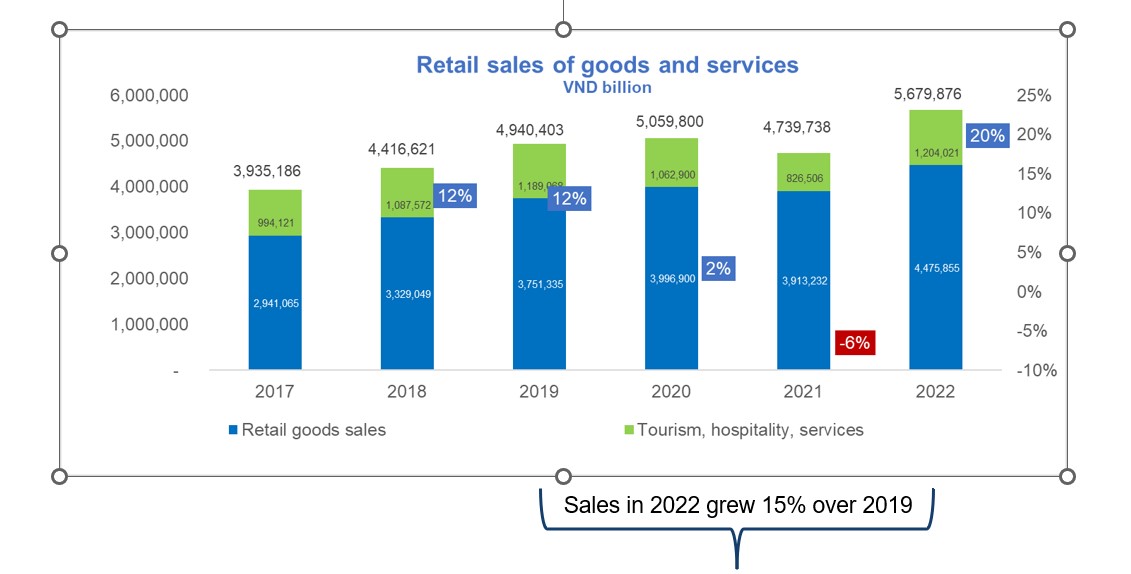
Modern trade’s contribution to retail sales has moved from 15% in 2005 to 26% in 2022.
There are now 9,071 modern trade stores nationally. Modern trade outlets are organised, they are usually self-service, there is a cashier and there is air conditioning; as opposed to among mom-and-pop stores or market stalls. There were many closures of modern formats in 2022, with a net gain of just 5%. Store counts over 2021:
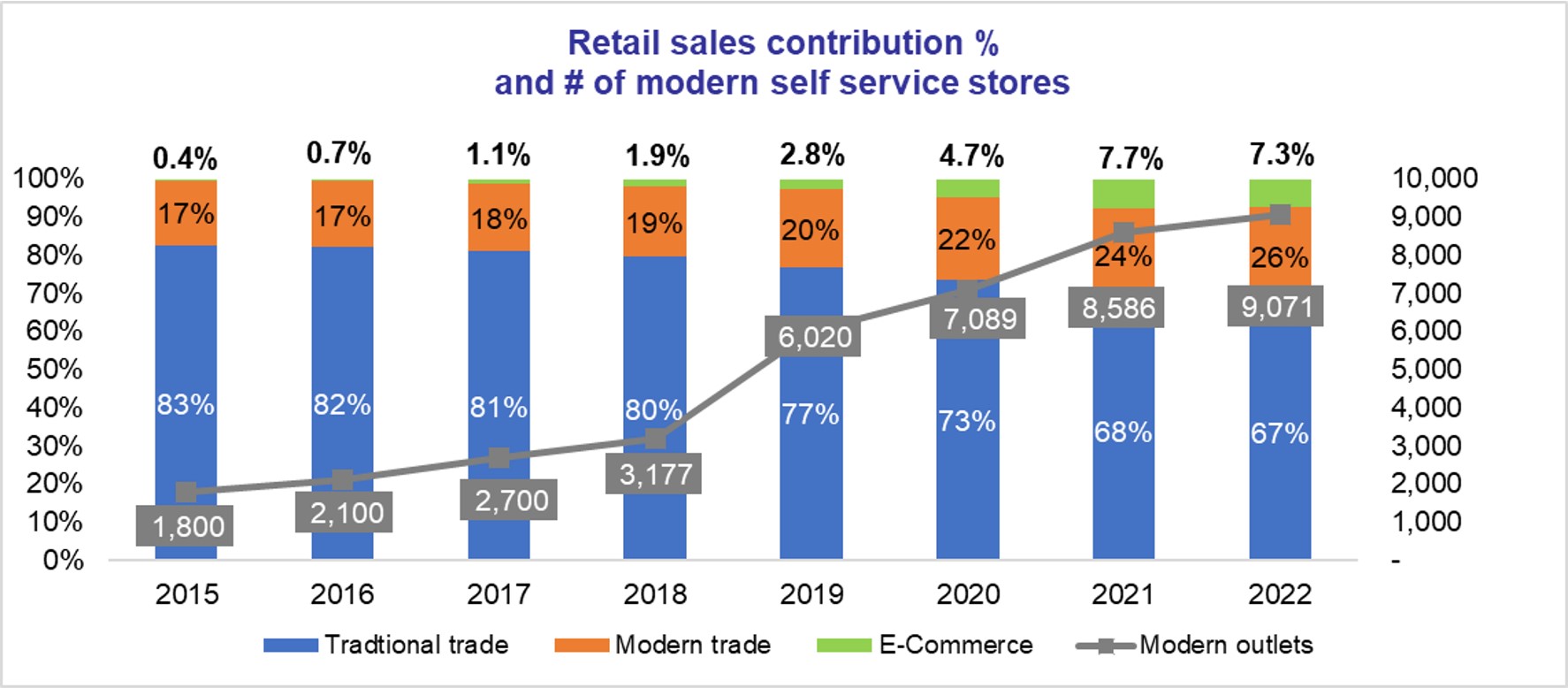
The most extensive closures were at Bach Hoa Xanh, with 418 fewer stores. This is a stark contrast to 2021 when the number of modern trade outlets grew by 20% and Bach Hoa Xanh accounted for 61% of all new outlets.
In 2022 the most expansive was FPT Long Chau with 483 new stores (60% of all new pharmacies).
The pandemic helped e-commerce in 2021 with 60% sales growth. E-commerce’s share of sales in 2022 is lower at 7.3%; however, retail sales grew by US$1 billion. Shopee is the dominant platform, followed by Lazada then thousands of independent sellers on Facebook.
Cimigo expects that online shopping will surpass the modern trade share of sales in 2028.
Download the free presentation on consumer trends
Domestic tourism replenishes the international void since the pandemic. Only 3% of tourists were international in 2022. One-third of inbound tourists in 2019 were from China, the return of these and those from further afield are expected to build through 2023. However, the brighter story is that domestic tourism is flourishing and signals rising affluence and a strengthening of the experience economy.
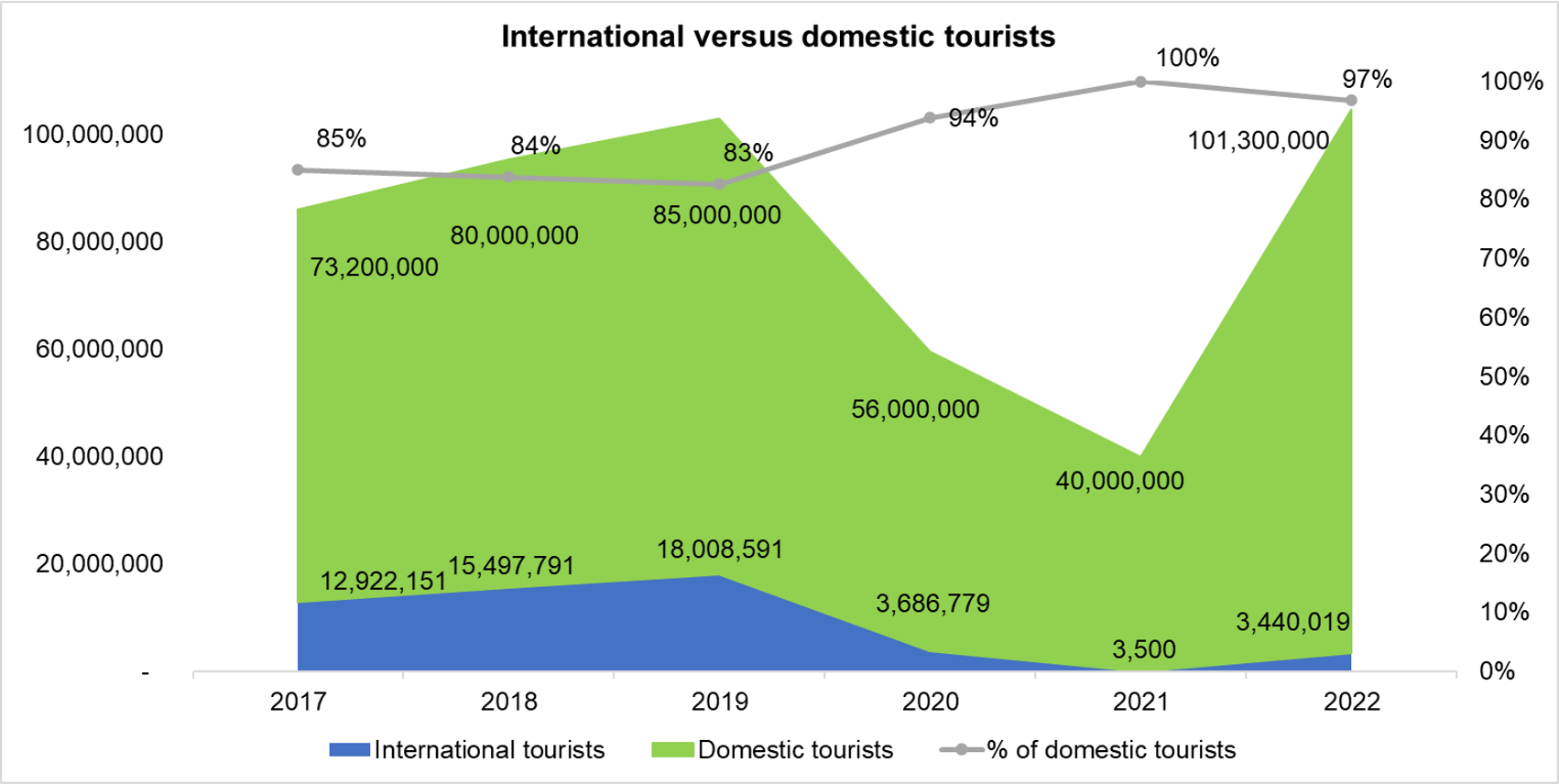
In 2022 97% of adults had a smartphone and 79% of the population had internet access. This ubiquitous digital access equates to more transformation, innovation and digital experiences. The internet economy represented 5.7% of GDP at US$23 billion in 2022. Online shopping takes the lion’s share at 60% followed by ads, media and games at 18%, ride-hailing and food delivery at 13% and online travel at 9%. The levels of consumer expenditure and high growth are indicative of the rapid shifts in consumer priorities and changing journeys to purchase.
On average Vietnase are spending 6 hours every day glued to a screen of some sort. If you, the reader, work in the eye care category, you should have a bright future. Media exposure in the past led to a strong dichotomy between urban and rural consumers. Now, these consumers are largely enjoying the same digital media channels for music, social, gaming, video streaming and news. Now that the urban and rural consumers have the same influences they have become much, much closer together in both attitude and behaviour.
Middle-class acceleration coupled with urban migration and lower birth rates means that households are smaller and wealthier. In 2022 there were 15,386,852 households have an income above US$ 644 (VND 15,000,000) per month. These households are classified as ABCD economic class. This equates to 54,749,213 people. In 2022 there were;
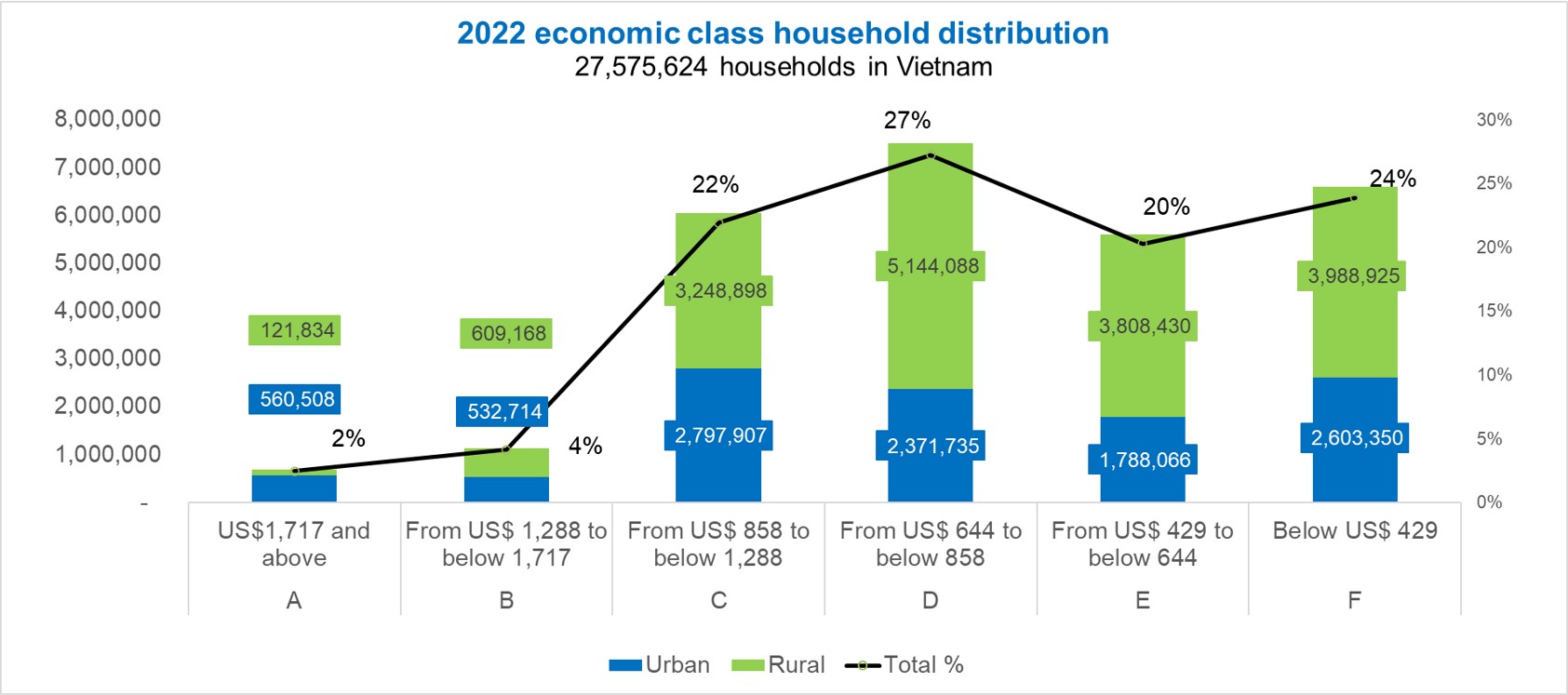
Download the free presentation on consumer trends
Vietnamese are becoming more health conscious. Consumers are changing some of their dietary habits in the way they eat and the way they purchase and which ingredients and benefits they seek. This applies to food more so than beverages, as beverage moments are more for enjoyment and indulgence. 49% have used supplements or traditional remedies in the last month to support their health and prevent long-term diseases, namely; multivitamins, traditional health remedies, minerals and collagen supplements.
Consumers expect to strengthen resistance (62%), immunity (53%), support bone and joint strength (44%), digestion (40%) and brain development (38%). For females, beauty benefits are strongly anticipated to provide anti-ageing (47%) and skin and hair support (48%).
Using traditional medicinal remedies is ingrained in Vietnamese culture. Animals and plants which are believed to have a strong impact on curing and healing specific ailments are well known to consumers. These are used in raw form or as ingredients added to wider supplements. Bird’s Nest is the most well-known traditional ingredient and is often cooked on its own or mixed with other ingredients. Cordyceps, saffron and black garlic are also common. Manufacturers increasingly use traditional remedies to provide compelling proof points in their foods, beverages and supplements.
Download the free report on Vietnam’s healthy food and beverage
70% of Vietnamese adults were banked in 2022. But immense opportunities exist for up-selling credit products to improve retail banking profitability. Digital transformation will continue to change the shape of retail banking. Improving customers’ digital experience and the ecosystem of digital products and services is key to future success.
Download the free report on Vietnam’s retail banking
Financial ecosystems are enabling e-commerce through mobile payments. E-wallets have a 66% penetration of youth aged 16 to 29 years old, although amongst all adults penetration is 39%. The e-commerce market was 88% cash on delivery in 2018 and this has now fallen to 64% in 2022. However, bank transfers represent 23% of transactions and e-wallets 13%. Momo is a dominant e-wallet player, ShopeePay from the leading e-commerce site, ZaloPay and then a multitude of others that operate in the market.
Vietnam drew US$2.6 billion in funding through 233 private deals in 2021. An estimated US$1.3 billion was raised to fund fintech in 2021. With valuations of US$1 billion or more, there were four unicorns at the end of 2021;
Sky Mavis (gaming – Axie Infinity)
Momo (e-wallet)
VNPAY (e-wallet)
Vinagame (Zalo and much more)
Despite recent high-profile removals of high-level officials, political stability remains assured in Vietnam. The geopolitical position and management of overseas influences remain formidable.
Download the free presentation on consumer trends
Vietnam will stand out as a high-growth economy over the next ten years. These are the key nine reasons why Vietnam will continue to prosper over the next decade and growth will be the strongest in Asia and across most of the world.
End.


Indonesia car survey: overcoming barriers of car purchase
Oct 08, 2024
Demand for passenger cars is declining The Indonesian automotive market in 2024 presents both

Vietnam retail banking 2024
Sep 17, 2024
Unlocking the future of retail banking Vietnam retail banking 2024 The world of retail banking is

Vietnam uninterrupted: a twenty-year journey
Mar 18, 2024
Trends in Vietnam: Vietnam uninterrupted: a twenty-year journey Trends in Vietnam. Witness

Hy Vu - Head of Research Department

Joe Nelson - New Zealand Consulate General

Steve Kretschmer - Executive Director

York Spencer - Global Marketing Director
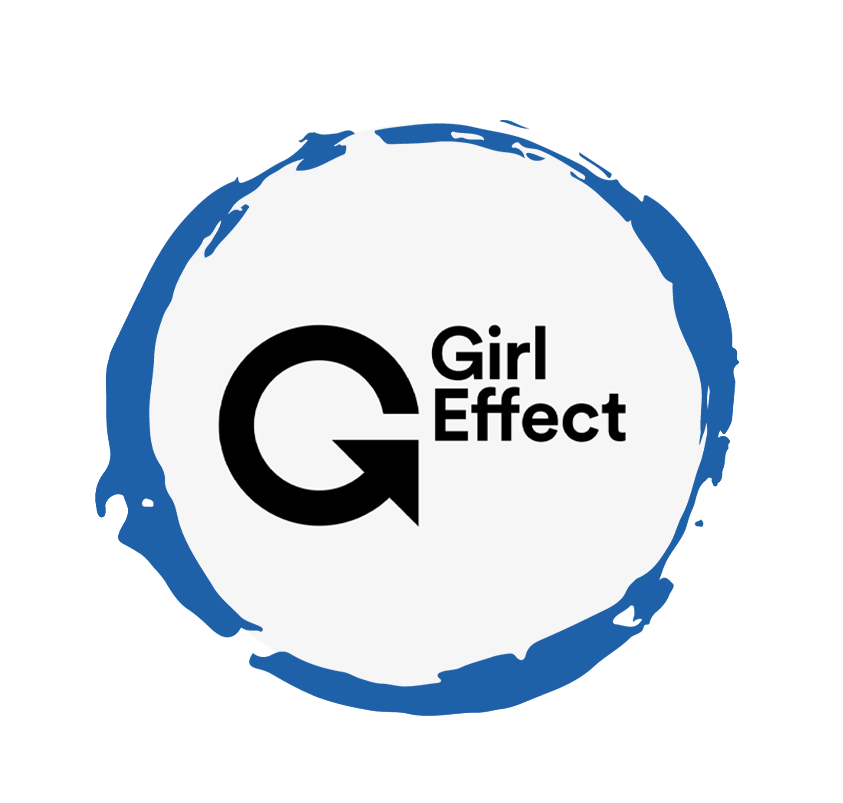
Laura Baines - Programmes Snr Manager

Mai Trang - Brand Manager of Romano

Hanh Dang - Product Marketing Manager

Luan Nguyen - Market Research Team Leader
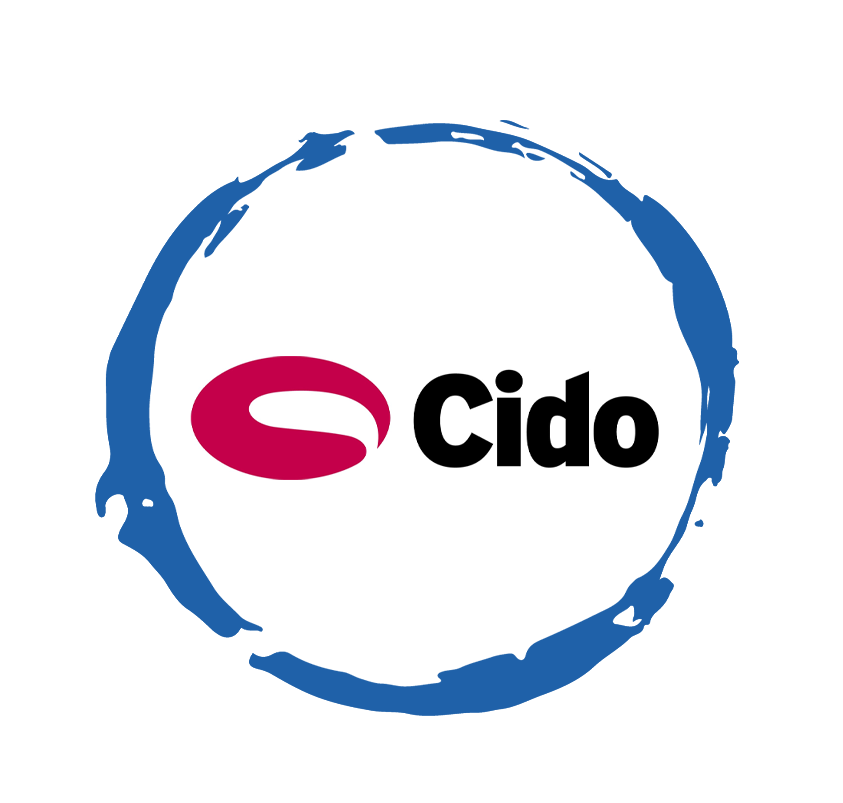
Max Lee - Project Manager

Chris Elkin - Founder

Ronald Reagan - Deputy Group Head After Sales & CS Operation
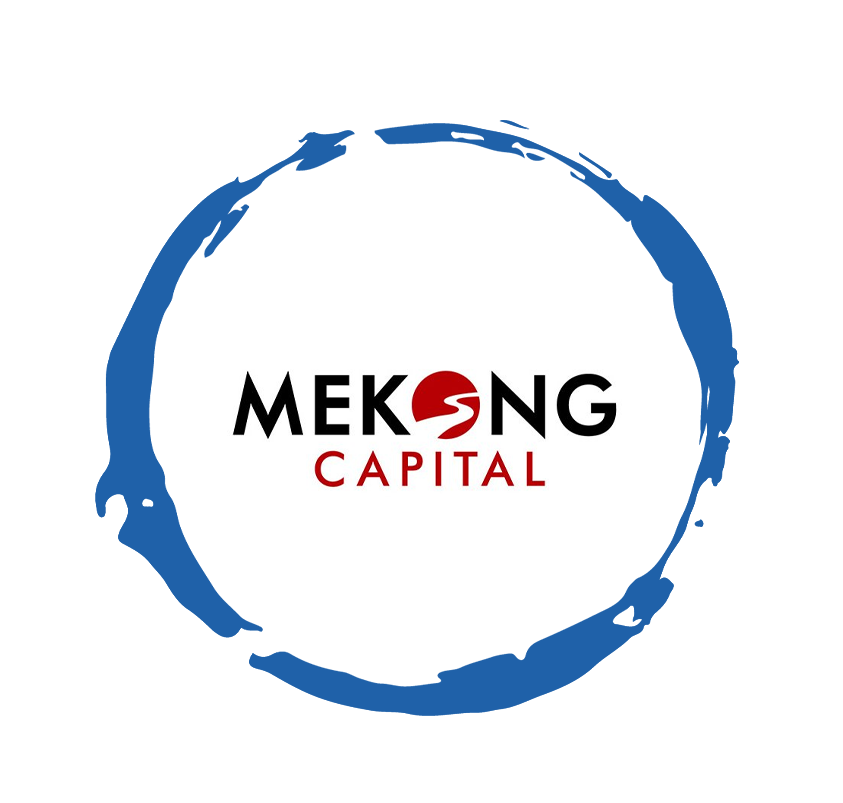
Chad Ovel - Partner

Private English Language Schools - Chief Executive Officer

Rick Reid - Creative Director

Janine Katzberg - Projects Director

Anya Nipper - Project Coordination Director

Dr. Jean-Marcel Guillon - Chief Executive Officer

Joyce - Pricing Manager

Matt Thwaites - Commercial Director

Aashish Kapoor - Head of Marketing

Kelly Vo - Founder & Host

Thanyachat Auttanukune - Board of Management

Hamish Glendinning - Business Lead

Thuy Le - Consumer Insight Manager

Richard Willis - Director

Ha Dinh - Project Lead

Geert Heestermans - Marketing Director

Louise Knox - Consumer Technical Insights

Aimee Shear - Senior Research Executive

Dennis Kurnia - Head of Consumer Insights

Tania Desela - Senior Product Manager

Thu Phung - CTI Manager

Linda Yeoh - CMI Manager

Cimigo’s market research team in Vietnam and Indonesia love to help you make better choices.

Cimigo provides market research solutions in Vietnam and Indonesia that will help you make better choices.

Cimigo provides a range of consumer marketing trends and market research on market sectors and consumer segments in Vietnam and Indonesia.

Cimigo provides a range of free market research reports on market sectors and consumer segments in Vietnam and Indonesia.
Xin cảm ơn. Một email kèm với đường dẫn tải báo cáo đã được gửi đến bạn.
Vui lòng điền thông tin vào biểu mẫu bên dưới để tải về báo cáo miễn phí.
Báo cáo sẽ được gửi vào email bạn điền ở bên dưới.
Please enter the information for free download.
The report will be sent to your email.
